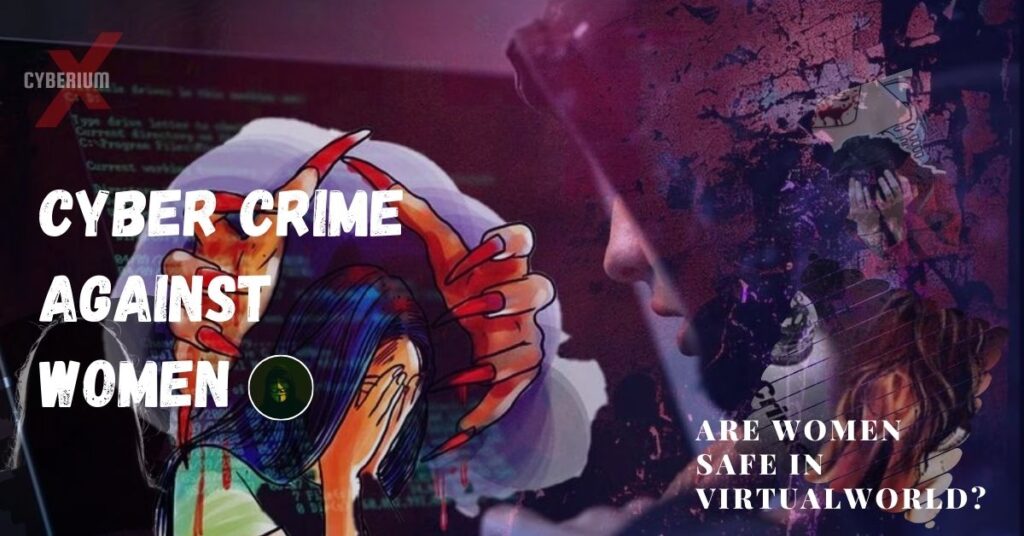The incidences of cyber crime has risen due to underreporting and the difficulty in detecting and substantiating such crimes. Unlike traditional monitoring, investigation, or auditing methods, cyber crime operates beyond conventional means and necessitates specialized understanding to address its complexities.
Women are disproportionately affected by cyber crime, enduring mental and emotional distress as a result. Many women experience feelings of distress, humiliation, and depression due to these crimes, which present significant challenges in terms of resolution and mitigation.
What is Cybercrime?
Cyber crime refers to illicit activities carried out via the internet and digital devices with the aim of intruding into others’ private spaces and causing distress through objectionable content and misconduct.
With internet usage becoming commonplace for educational, social, entertainment, and professional needs in today’s digital era, women are actively participating in online platforms for work or education and frequently engaging with social media.
While many individuals utilize the internet and digital platforms for educational and recreational purposes, there are individuals who exploit these tools to harass and intimidate online users, particularly women. Such criminal behavior falls under the category of cybercrime, as it occurs within the realm of cyberspace.
Cyber Crime Against Women
In the digital age, women are disproportionately targeted by malicious online activities that inflict severe psychological and emotional harm. Blackmail, threats, cyberpornography, and the dissemination of explicit sexual content are among the prevalent cyber crimes targeting women. Additionally, women are frequently subjected to stalking, bullying, defamation, image manipulation, and the creation of fraudulent profiles.
Cyber violence employs computer technology to breach women’s personal information and utilize the internet for harassment and exploitation. Women are increasingly vulnerable targets due to their tendency to trust others and their lack of awareness regarding potential consequences.
Types of Cybercrime Targeting Women
Cyber crime against women involves the use of computer networks or mobile phones to make derogatory comments about women based on their gender and sexual orientation and to engage in activities that violate the privacy and dignity of women and cause them distress.
The various forms of cyber crimes against women are outlined as follows:
Cyber Defamation : This type of activity involves blackmailing and exposing the victim’s personal information or altered images. This type of activity often involves blackmailing and soliciting sexual favors for the victim.
Cyber Hacking: These women fall victim to cyber hacking when they are asked to click on unauthorised URLs or download unauthorised apps that disclose all their personal data on their phones. The hackers use these data for illegal money transactions and other illegal activities.
Cyber Stalking:It involves trying to get in touch with women on social media platforms for no good reason, posting threatening messages on a chat room, and harassing the victims by sending them inappropriate emails and text messages to cause mental distress
Cyber Bullying: Cyberbullying is a form of online harassment and bullying that targets a victim through the use of a digital platform. It involves the posting of harmful and offensive content, images, or videos, as well as rape and death threats.
Cyber Grooming: In this case, a man establishes an online relationship with a woman and tries to pressurise her for undue favors or sexual favors.
Pornography: This type of crime involves posting altered images of victims on social media and using them for sexual exploitation, sometimes even demanding money to take them down.
Impact of Cyber Crime on Women
Cyber crime can have a wide-reaching and impactful effect on women, impacting their physical, mental, and emotional health. Here are some of the most significant effects:
Emotional Distress and Psychological Trauma: Women who are victims of cybercrime, such as online harassment, cyberbullying, or revenge porn, often experience significant emotional distress and psychological trauma. The invasion of privacy, violation of personal boundaries, and public humiliation can lead to feelings of fear, shame, anxiety, and depression.
Damage to Reputation and Social Standing: Cyber crime can tarnish a woman’s reputation and social standing, especially if sensitive or compromising information is exposed online. This can have long-lasting consequences on personal relationships, career opportunities, and social acceptance within communities.
Financial Loss and Economic Harm: Women may suffer financial loss and economic harm due to cyber crimes such as identity theft, online fraud, or phishing scams. Cybercriminals may target women for financial exploitation, draining bank accounts, stealing personal information, or defrauding them through deceptive schemes, leading to financial instability and hardship.
Impact on Personal and Professional Relationships: Cyber crime can strain personal and professional relationships for women. Victims may experience difficulties trusting others, fear of further victimization, and social withdrawal due to the fear of judgment or stigma associated with being targeted online.
Physical Safety Concerns: In cases of cyberstalking, intimate partner violence, or online harassment escalating into real-world threats, women may face significant concerns for their physical safety and well-being. Cybercriminals may use technology to track, monitor, or harass women in their daily lives, creating a constant sense of fear and vulnerability.
Barriers to Seeking Help and Support: Women who experience cyber crime may encounter barriers to seeking help and support, including fear of retaliation, shame, or disbelief from others. Limited access to resources and support services specifically tailored to address cyber victimization can further exacerbate their isolation and distress.
Loss of Privacy and Control: Cyber crime can strip women of their sense of privacy and control over their personal information and online presence. The unauthorized dissemination of private or intimate content, such as revenge porn, can leave women feeling violated and powerless, with lasting implications for their sense of autonomy and self-worth.
Addressing the impact of cyber crime on women requires a comprehensive approach that encompasses legal protections, technological safeguards, support services, and public awareness campaigns. Empowering women with knowledge about online safety, promoting digital literacy, and fostering a supportive environment for victims to seek help and recovery are essential steps in mitigating the impact of cyber victimization.
Protective Measures Against Cyber Crimes
- Monitor irrelevant or fraudulent messages and emails.
- Refrain from responding to emails soliciting personal information.
- Avoid accessing fraudulent websites or apps requesting personal details.
- Safeguard your email address and password.
- Utilize strong and secure passwords, updating them regularly.
- Exercise caution and refrain from clicking on unrecognized URLs or downloading unknown apps.
- Stay informed about cyber laws and policies to remain up-to-date on potential risks and protections.
Legal Frameworks Against Cyber Crime
Every individual utilizing cyberspace is bound by universal laws governing its use. Cyber laws address legal matters stemming from networked computer technology and digital platforms. These regulations serve to safeguard victims of cybercrimes and aid them in addressing their concerns and seeking justice.
The Indian Penal Code (IPC), 1860, outlines specific punishable offenses under Section 354, which are as follows:
Section 354A: Engaging in the demand for sexual favors, displaying objectionable pictures against a woman’s consent, making sexual remarks, or engaging in sexual harassment can result in imprisonment of up to 3 years along with fines.
Section 354C: Photographing or publishing pictures of a woman engaged in a private act without her consent may lead to imprisonment ranging from 3 to 7 years.
Section 354D: Contacting a woman online and sending irrelevant emails/messages despite the woman’s clear disinterest can result in imprisonment for 5 years along with fines.
The Information Technology Act of 2000 includes provisions for penalties under the following sections:
Section 66C: Committing cyber hacking with the intent to steal identities is a punishable offense, carrying a prison sentence of 3 years and fines up to Rs. 1 lakh.
Section 66E: Addresses the offense of capturing, publishing, or transmitting pictures of women in circumstances that invade privacy, resulting in a 3-year imprisonment.
Section 67A: Prohibits the publication and transmission of sexually explicit content, punishable by imprisonment ranging from 5 to 7 years.
The Cyber Crime Prevention Act of 2012 aims to prevent and prosecute individuals engaged in cyber crimes that compromise the privacy, confidentiality, and integrity of information through computer-related criminal activities.
The Indecent Representation of Women (Prohibition) Act governs and forbids the indecent portrayal of women across various media platforms, including audio-visual media, electronic content, and distribution of material on the Internet, aiming to regulate the depiction of women online.
The Cyber Crime Prevention against Women and Children (CCPWC) scheme is implemented to devise effective strategies for addressing cyber crimes targeting women and children in India. It facilitates cybercrime victims in lodging complaints through an online reporting platform.
Furthermore, the platform furnishes information about law enforcement and regulatory agencies at both local and national levels. The CCPWC also conducts awareness programs, starting from schools, as a proactive measure to combat cyber crimes.
Conclusion
As our society increasingly relies on technology, instances of cyber violence are becoming more prevalent, particularly targeting women who are often perceived as vulnerable. Legislation must take proactive steps to combat this trend by imposing stringent penalties on offenders. Additionally, addressing cyber crimes against women requires a concerted effort to raise awareness and enhance understanding of cyber practices, privacy protection measures, and legal safeguards. By fostering greater awareness and knowledge in these areas, we can work towards creating a safer digital environment for everyone, regardless of gender.
Stay Safe!!
Team CyberiumX


